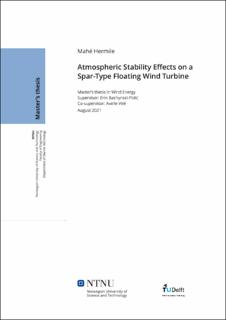| dc.contributor.advisor | Bachynski-Polić, Erin | |
| dc.contributor.advisor | Viré, Axelle | |
| dc.contributor.author | Hermile, Mahé | |
| dc.date.accessioned | 2021-11-15T18:19:25Z | |
| dc.date.available | 2021-11-15T18:19:25Z | |
| dc.date.issued | 2021 | |
| dc.identifier | no.ntnu:inspera:79321377:64964112 | |
| dc.identifier.uri | https://hdl.handle.net/11250/2829695 | |
| dc.description.abstract | Simuleringer av en flytende vindturbin av spar-type som støtter DTU 10 MW referanseturbin under monterte atmosfæriske forhold, utføres. Atmosfæriske forhold modelleres ved bruk av turbulente modeller anbefalt av IEC: Mann-modellen og IEC Kaimal og eksponentiell sammenhengsmodell. Modellparametere er montert på målinger på FINO-1-plattformen for å generere turbulente bokser som er så nær målingene som mulig. Simuleringene utføres ved bruk av OpenFAST for tre gjennomsnittlige vindhastigheter: 7,5, 12 og 16 m / s og kraftlovens vindprofil brukes med montert skjæreksponent. Bevegelser, vind, belastningsspektre blir kvantifisert ved hjelp av WAFO verktøykasse, og belastningene blir vurdert med kortsiktige skadeekvivalenter ved bruk av MLife. Avhengig av vindmodellen, varierer globale bevegelser med opptil 52%. Generelt resulterte Kaimal i høyere stigning og stigningsbevegelser, og det motsatte ble funnet for gjevebevegelsene. Innflytelsen av atmosfærisk stabilitet på globale bevegelser ble også funnet å være viktig, ustabile forhold som gir de største bevegelsene og stabile forhold lavest. Det ble observert at vindmodellen påvirket lysstyrken og tårnbelastningen. Mann resulterte i opptil 35% høyere belastning på tårnens topp gjeveøyeblikk og Kaimal resulterte i opptil 30% høyere spenningsbelastning. Tårnbase foran-akter bøyemoment og bladrot utenfor planetøyeblikket var ikke veldig følsom for valg av vindmodell. Atmosfærisk stabilitet hadde innflytelse på alle belastninger med opptil 30%. Ustabile forhold førte til mest skade mens stabile forhold generelt førte til det minste. Hvorvidt valget av vindmodell eller endringen i atmosfærisk stabilitet har større innflytelse på plattformens globale bevegelser og belastningene var avhengig av vindhastigheten, frihetsgraden eller belastningen som vurderes. Det ble funnet at vindmodeller alltid skulle vurdere atmosfæriske forhold, ikke bare nøytrale. Til slutt ble det undersøkt virkningen av parametervariasjoner av Mann turbulensmodell på vinden, globale bevegelser og belastninger. Det ble funnet at turbulensintensitet er påvirket av de tre parametrene og har større innvirkning enn forskjellene i sammenheng. | |
| dc.description.abstract | Simulations of a spar-type floating wind turbine supporting the DTU 10 MW reference turbine under fitted atmospheric conditions are performed. Atmospheric conditions are modelled using the turbulent models recommended by the IEC: the Mann model and the IEC Kaimal and exponential coherence model. Model parameters are fitted to measurements at the FINO-1 platform to generate turbulent boxes that are as close as possible to measurements. The simulations are carried out using OpenFAST for three mean wind speeds: 7.5, 12 and 16 m/s and the power law wind profile is used with fitted shear exponent. The motions, wind, loads spectra are quantified using the WAFO toolbox and the loads are assessed with short-term damage-equivalent loads using MLife. Depending on the wind model, global motions differ by up to 52%. Generally, Kaimal resulted in higher surge and pitch motions, and the opposite was found for the yaw motions. The influence of atmospheric stability on global motions was found to be important as well, unstable conditions giving the largest motions and stable conditions the lowest. It was observed that the wind model influenced the fairlead tension and tower top loads. Mann resulted in up to 35% higher loads on the tower top yaw moment and Kaimal resulted in up to 30% higher fairlead tension loads. Tower base fore-aft bending moment and blade root out-of-plane moment were not very sensitive to the choice of wind model. Atmospheric stability had an influence on all loads by up to 30%. Unstable conditions led to the most damage while stable conditions generally led to the least. Whether the choice of the wind model or the change in atmospheric stability has more influence on the global motions of the platform and the loads depended on the wind speed, the degree of freedom or the load considered. It was found that wind models should always consider atmospheric conditions, not only neutral. Finally, impact of Mann turbulence model parameter variations on the wind, global motions and loads was investigated. It was found that turbulence intensity is influenced by the three parameters and has a bigger impact than the differences in coherence. | |
| dc.language | eng | |
| dc.publisher | NTNU | |
| dc.title | Atmospheric Stability Effects on a Spar-Type Floating Wind Turbine | |
| dc.type | Master thesis | |
